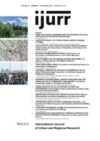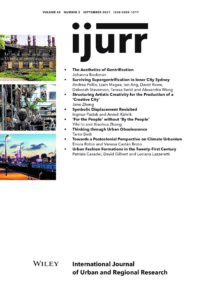Volume 45 Issue 5 September 2021
In This Issue...
It is my delight to introduce the September 2021 issue of IJURR, which includes insightful papers that bring together variegated urban experiences across the world, in particular Washington DC, Sydney, Shanghai, Bombay/Mumbai, and Tallinn. These pieces address some of the key debates in critical urban studies, which relate to gentrification, displacement, obsolescence, creative city, and climate urbanism.
Three papers directly engage with the questions of gentrification and displacement. By examining a case of mural installations (Mondrian Gate) in the late 1980s in Washington DC, Johanna Bockman sheds light on how urban aesthetics, artists and their products as well as art purveyors lay the foundation for gentrification to arrive in such a way as to reinforce its “settler colonial nature” vis-à-vis “anti-colonial opponents” (p.761). Here, such imposition of a particular version of settler aesthetics of gentrification runs into contestation with the situated black geography and black globalizations, calling further questions about the relationship between race and gentrification as well.
While Johanna Bockman’s contribution reveals the repressive nature of artistic practices that facilitate gentrification, the paper by Andrea Pollio, Liam Magee, Ien Ang, David Rowe, Deborah Stevenson, Teresa Swist and Alexandra Wong examines inner city Sydney to highlight the spatial (use of adaptive spaces) and economic (makeshift economies) survival strategies of cultural workers who have become victimised in the process of Sydney’s ‘supergentrification’. Informal in nature, such survival strategies are considered to be key to the retention of the diversity, both cultural and social, threatened by Sydney’s gentrification.
The paper by Ingmar Pastak and Anneli Kährik visits the place-making narratives in Tallinn to interrogate the extent to which gentrification can be contextualised in the transitional environments of Tallinn as a post-industrial, post-Soviet city. By employing the emergent concept of symbolic displacement and ‘un-homing’ in the extant literature, they provide a persuasive case of how place-making trajectories in their case study neighbourhoods can be seen as gentrification despite not entailing direct or physical displacement per se, invoking the importance of the social, cultural and symbolic capital in action. In doing so, they attempt to counter some of the existing narratives that hesitate to extend the concept of gentrification beyond Anglo-American contexts.
Two of the papers in this issue shift our attention to Shanghai, engaging nevertheless with the questions about aesthetics, cultural intervention, and urban spatial transformation. In the paper about Shanghai’s urban sculpture planning, Jane Zheng critiques the ‘creative city’ thesis, and puts forward the concept of ‘structured creativity’ to explain how artistic creativity operates within institutional environments governed by the authoritarian state. While artists’ creativity is not necessarily suppressed by the state, such political contexts as observed in China render artistic creativity “channeled towards utilitarian projects in service of the community and the creative economy” (p.795).
Yifei Li and Xiaohua Zhong, on the other hand, examine Shanghai’s waterfront development to understand how such development has expanded the citizens’ right to certain urban space while limiting their participation. What comes out interestingly from their study is the ways in which the local state has perceived the development “as a gift to the people” (p.836), while invoking the discourse of ‘quality people’ that refers to those who are perceived to be desirable in the eyes of the state and therefore worthy of its service.
Shifting our attention to Bombay/Mumbai, Tarini Bedi’s paper on urban obsolescence is a perceptive piece that historically revisits discourses of obsolescence in urban settings. Through the case study of Bombay/Mumbai’s taxi trade, Bedi asks “what happens when particular technologies and linear understandings of progress rooted in obsolescence pass over or attempt to erase certain urban subjects.” (p.850), paradoxically enabling the rise of new political possibilities when such obsolescence evokes the politics of Joona (authentic and original).
This issue also includes two Interventions essays. From a postcolonial perspective, Enora Robin and Vanesa Castán Broto critically review the extant scholarship on climate urbanism. While acknowledging the contributions made by the existing literature, they also caution that it exhibits limitations by placing “an emphasis on technological solutions and an overreliance on familiar contexts of climate action” (p.869). In doing so, they call for more attention to “other forms of climate urbanism” that may take place “outside dominant circuits of knowledge and market-led interventions” (p.875).
The second Interventions essay by Patrizia Casadei, David Gilbert and Luciana Lazzeretti examines the fashion city that has arguably become one of the strategies for urban economic development. By drawing upon Weber’s ideal type approach, the authors attempt to devise an analytical framework that hinges on three ideal types and acts as a heuristic tool to interrogate the characteristics of contemporary fashion cities and their position in the world economy.
Collectively, the authors in this issue help us re-visit conventional concepts in urban studies and contest the existing practices of urban socio-spatial restructuring in diverse political and cultural settings, while encouraging us to think about the importance of alternative narratives and discourses in challenging the hegemony of the ruling capitalist relations.
— Hyun Bang Shin
Articles
The Aesthetics of Gentrification: Modern Art, Settler Colonialism, and Anti-Colonialism in Washington, DC
Published online on Aug 23rd, 2021 | DOI: 10.1111/1468-2427.13046 (p 759-777)
Surviving Supergentrification in Inner City Sydney: Adaptive Spaces and Makeshift Economies of Cultural Production
Published online on Jun 17th, 2021 | DOI: 10.1111/1468-2427.13015 (p 778-794)
Structuring Artistic Creativity for the Production of a ‘Creative City’: Urban Sculpture Planning in Shanghai
Published online on Apr 6th, 2021 | DOI: 10.1111/1468-2427.12986 (p 795-813)
Symbolic Displacement Revisited: Place-making Narratives in Gentrifying Neighbourhoods of Tallinn
Published online on Sep 20th, 2021 | DOI: 10.1111/1468-2427.13054 (p 814-834)
‘For the People’ Without ‘by the People’: People and Plans in Shanghai’s Waterfront Development
Published online on Nov 2nd, 2020 | DOI: 10.1111/1468-2427.12964 (p 835-847)
Thinking through Urban Obsolescence: Tinkering, Repair and the Politics of Joona in Bombay/Mumbai’s Taxi Trade
Published online on Nov 17th, 2020 | DOI: 10.1111/1468-2427.12948 (p 848-868)
Interventions
Towards a Postcolonial Perspective on Climate Urbanism
Published online on Jan 5th, 2021 | DOI: 10.1111/1468-2427.12981 (p 869-878)
Urban Fashion Formations in the Twenty‐First Century: Weberian Ideal Types as a Heuristic Device to Unravel the Fashion City
Published online on Nov 17th, 2020 | DOI: 10.1111/1468-2427.12961 (p 879-896)
Book Reviews
Deljana Iossifova 2020: Translocal Ageing in the Global East: Bulgaria’s Abandoned Elderly. London: Palgrave Macmillan
Published online on Sep 20th, 2021 | DOI: 10.1111/1468-2427.13055 (p 897-898)
Haris Malamidis 2020: Social Movements and Solidarity Structures in Crisis-Ridden Greece. Amsterdam: Amsterdam University Press
Published online on Sep 20th, 2021 | DOI: 10.1111/1468-2427.13056 (p 898-900)
Alison H. Alkon, Yuki Kato and Joshua Sbicca (eds.) 2020: A Recipe for Gentrification: Food, Power, and Resistance in the City. New York: New York University Press
Published online on Sep 20th, 2021 (p 900-902)
Susanne Soederberg 2021: Urban Displacements: Governing Surplus and Survival in Global Capitalism. London and New York: Routledge
Published online on Sep 20th, 2021 | DOI: 10.1111/1468-2427.13058 (p 902-903)
Andrew Herscher 2017: Displacements: Architecture and Refugee. Berlin: Sternberg Press
Published online on Sep 20th, 2021 | DOI: 10.1111/1468-2427.13059 (p 904-905)
Issues in this volume
July 2021
September 2021
November 2021
March 2021
May 2021
January 2021

